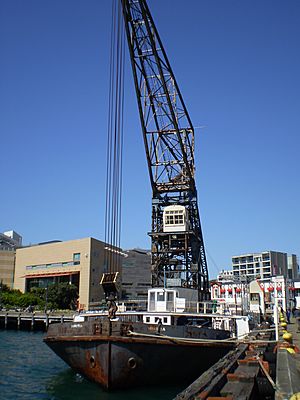Hikitia facts for kids

Hikitia at the Taranaki Street wharf
|
|
Quick facts for kids History |
|
|---|---|
| Name | Hikitia |
| Owner | Maritime Heritage Trust of Wellington |
| Port of registry | Wellington |
| Builder | Fleming & Ferguson, Paisley, Scotland |
| Yard number | 486 |
| Launched | 15 April 1926 |
| Maiden voyage | 29 September 1926 |
| Identification | IMO number: 5150393 |
| Status | Operational |
| General characteristics | |
| Tonnage | 746 GRT |
| Displacement | 926 tonnes |
| Length | 160.1 ft (48.8 m) |
| Beam | 52.3 ft (15.9 m) |
| Depth | 11.35 ft (3.5 m) |
| Installed power | steam engines originally fed by coal-fired Scotch boilers, later replaced in 1963 by oil-fired boilers and then by small modern package boilers. |
| Propulsion | twin screw |
| Speed | about 10 kn (18.5 km/h) |
Imagine a giant floating crane that moves itself! That's Hikitia, a special steam-powered crane ship in Wellington, New Zealand. She's not just any old ship; she's believed to be the only working steam crane of her kind left in the entire world. Hikitia even had a sister ship named Rapaki. Rapaki used to work in the Port of Lyttelton. After her working days, some of her parts were given to Hikitia to help keep her going.
Contents
How Hikitia Works
Hikitia is a powerful ship with a huge crane. She was built in Scotland. The part of the ship that floats, called the hull, was made by a company called Fleming & Ferguson. The giant crane itself was built by Sir William Arrol & Co. in Glasgow.
The Crane's Power
The crane on Hikitia is incredibly heavy, weighing 310 tonnes! It was designed to lift very heavy objects, up to 80 tonnes. But this amazing crane has lifted even more! When helping to clear the wreck of a ship called TEV Wahine, it's thought that Hikitia lifted a massive 140 tonnes. In 2004, she lifted 100 tonnes to show she could still handle her 80-tonne lifting license. In 2009, Hikitia lifted a 22-tonne ice plant in Lyttelton.
Engine Evolution
Hikitia moves using two propellers, called twin screws. These were originally powered by steam engines. The steam came from a large boiler that burned coal. In 1963, this coal boiler was replaced with a similar one that used oil instead. Then, in 1980, even that boiler was changed. Now, Hikitia uses two smaller, more modern boilers that were made locally. These new boilers produce a bit less steam than the very first ones.
Adventures and Upgrades
Hikitia has spent most of her life working in Wellington. But sometimes, she needs a trip for important repairs.
A Trip to Lyttelton
In June 2009, Hikitia traveled all the way to Lyttelton. This was her first time leaving Wellington since she arrived in 1926! She went there for important repairs to her hull and other parts that are underwater. While she was in Lyttelton, she helped move a 22-tonne ice plant between different wharves. This work helped pay for some of the repairs she had done in the port's dry dock.

